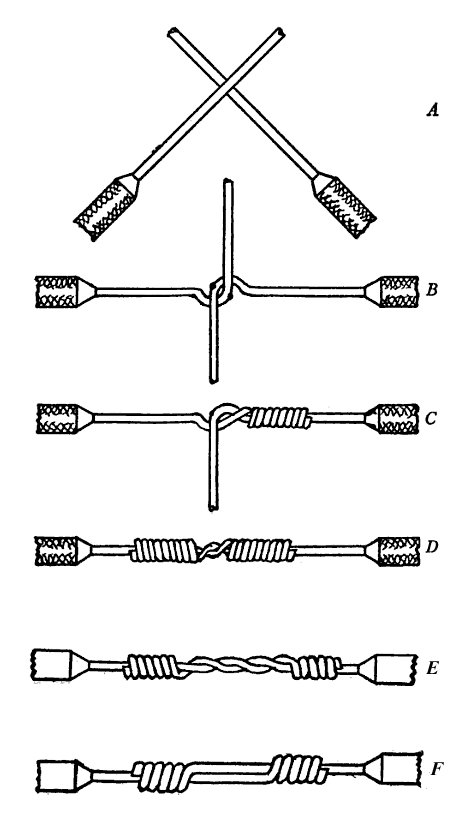Western Union Splice on:
[Wikipedia]
[Google]
[Amazon]
 The Western Union splice or lineman splice is a method of joining
The Western Union splice or lineman splice is a method of joining
 The Western Union splice or lineman splice is a method of joining
The Western Union splice or lineman splice is a method of joining electrical cable
Electricity is the set of physical phenomena associated with the presence and motion of matter possessing an electric charge. Electricity is related to magnetism, both being part of the phenomenon of electromagnetism, as described by Maxwel ...
, developed in the nineteenth century during the introduction of the telegraph
Telegraphy is the long-distance transmission of messages where the sender uses symbolic codes, known to the recipient, rather than a physical exchange of an object bearing the message. Thus flag semaphore is a method of telegraphy, whereas ...
and named for the Western Union
The Western Union Company is an American multinational financial services corporation headquartered in Denver, Denver, Colorado.
Founded in 1851 as the New York and Mississippi Valley Printing Telegraph Company in Rochester, New York, the co ...
telegraph company. This method can be used where the cable may be subject to loading stress. The wrapping pattern design causes the join to tighten as the conductors pull against each other.
History
In 1915, ''Practical Electric Wiring'' described it as being "by far the most widely used splice" in practical electrical wiring work. NASA included the splice in its technical standard ''Workmanship Standard for Crimping, Interconnecting Cables, Harnesses, and Wiring'', first produced in 1998.Construction
The 1915 textbook ''Practical Electric Wiring'' describes the construction of the Western Union splice; short tie and long tie. The short tie splice has it being formed after stripping the insulation from a pair of wires for several inches, each, crossing the wires left over right as shown in figure part A; then, a hooked cross (figure part B) is formed holding the crossing point of the two wires, and pulling the right wire tip toward and pushing the left wire tip away from the worker, leaving the tips oriented vertically as shown. The wires are then held withpliers
Pliers are a hand tool used to hold objects firmly, possibly developed from tongs used to handle hot metal in Bronze Age Europe. They are also useful for bending and physically compressing a wide range of materials. Generally, pliers consi ...
to the left of their crossing point while the right splice is formed by continuing to wind the wire tip away from the worker, creating 5–6 twists snug against the core wire and against each preceding twist. NASA recommend "tight, with no gaps between adjacent turns". The wires are then again held with pliers
Pliers are a hand tool used to hold objects firmly, possibly developed from tongs used to handle hot metal in Bronze Age Europe. They are also useful for bending and physically compressing a wide range of materials. Generally, pliers consi ...
, but on the first-made twist, to the right of the crossing point, and then the left splice is formed by winding the remaining wire tip toward the worker for a comparable 5–6 snug twists. The splice wire ends are then trimmed as needed, and the splice may then be soldered, and/or covered (e.g., with a heat-shrunk tube of insulation).
''Practical Electric Wiring'' described the splice as having two variations, the "short tie" (figure part D) and "long tie" (figure parts E or F), with the latter examples having a "twist between wrappings hat
A hat is a Headgear, head covering which is worn for various reasons, including protection against weather conditions, ceremonial reasons such as university graduation, religious reasons, safety, or as a fashion accessory. Hats which incorpor ...
allows a better chance for solder
Solder (; North American English, NA: ) is a fusible alloy, fusible metal alloy used to create a permanent bond between metal workpieces. Solder is melted in order to wet the parts of the joint, where it adheres to and connects the pieces aft ...
to pass in between the wires". The book suggested the long tie variant more suited to splices where soldering was intended. However, this was not backed up by NASA testing.
Testing
The NASA tests included soldering, and were performed to an organizationalstandard operating procedure
A standard operating procedure (SOP) is a set of step-by-step instructions compiled by an organization to help workers carry out routine operations. SOPs aim to achieve efficiency, quality output, and uniformity of performance, while reducing mis ...
(NASA-STD-8739.3) for a solder termination, which includes a number of specific requirements, including "proper insulation spacing"; tight wrapping; trimming of wire ends to prevent protrusions through the solder; and over-sleeving with a transparent or translucent heat shrink seal to cover the completed splice and all exposed metal.
NASA found both the short and long tie variants to be strong when soldered. The splices were examined in tensile strength
Ultimate tensile strength (also called UTS, tensile strength, TS, ultimate strength or F_\text in notation) is the maximum stress that a material can withstand while being stretched or pulled before breaking. In brittle materials, the ultimate ...
("pull") tests on 16 and 22 American wire gauge wire; even the short tie variation of the Western Union splice performed well after soldering. The test splices never failed at the splice (instead breaking outside of the splice area), leaving NASA to conclude that "the solder connection at the splice was as strong or stronger than the un-spliced wires".
See also
* T-splice * Rat-tail spliceReferences
{{Splices Telecommunications equipment Electrical wiring Splices Western Union